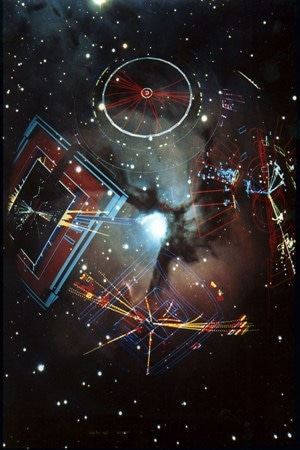May 19 2016
At the end of April, Brandeis professor of physics Gabriella Sciolla traveled to Switzerland to resume her research at the Large Hadron Collider (LHC), which was shutdown in December for repairs and upgrades.
 This results of collisions between electrons and positrons at CERN superimposed on a background of stars. (CERN)
This results of collisions between electrons and positrons at CERN superimposed on a background of stars. (CERN)
Inside the LHC, protons are smashed together at an unprecedented 10-trillion volts of energy, enough to propel the particles at close to the speed of light. Amidst the collision’s debris, scientists hope to find answers to some of physics’ biggest unsolved questions.
In addition to Sciolla, three other Brandeis professors are involved with the LHC — Jim Bensinger, Craig Blocker and Hermann Wellenstein. Together they form the Brandeis experimental high energy physics group.
Brandeis Now sat down with Sciolla to ask her about her work at the LHC.
What are you looking for?
Never before seen subatomic particles. I like to think of them as new building blocks of the universe.
Why is it so important to find them?
For the last 40 years particle physics has relied on a theory called the Standard Model to explain how the building blocks of the universe work. There are 17 elementary particles that comprise the Standard Model. We know there must be other particles, but we don’t know exactly what they are. What we’re doing is trying to find some of the particles predicted by these theories and at that point we can say, ‘Aha, this is the right theory.’
Why do we even think these other particles exist?
Here’s just one example, but it’s a big one. We know that 85 percent of the mass of the universe comes from something known as dark matter. As the name suggests, we can’t see or observe it. Dark matter cannot be made of particles that belong to the Standard Model. We need to find new particles — and new theories — to explain it.
What are the names of some of these particles?
Gravitons, the heavy Higgs Boson, and the Z' (pronounced "Z-prime").
Didn’t they already discover the Higgs Boson?
This is the heavy Higgs Boson, six times more massive than the Higgs. The Higgs is part of the Standard Model. The heavy Higgs isn’t.
What happens if you succeed?
It tells us that nature is not just made of those little building blocks that are part of the Standard Model. Now we have experimental proof that it’s much more complicated. What we’ve seen so far is just the tip of the iceberg. We begin with what we call the New Physics.